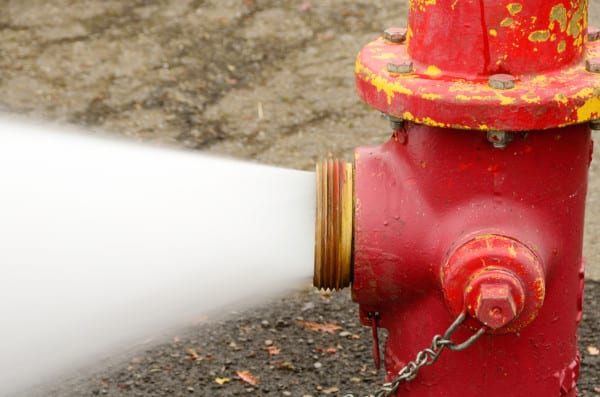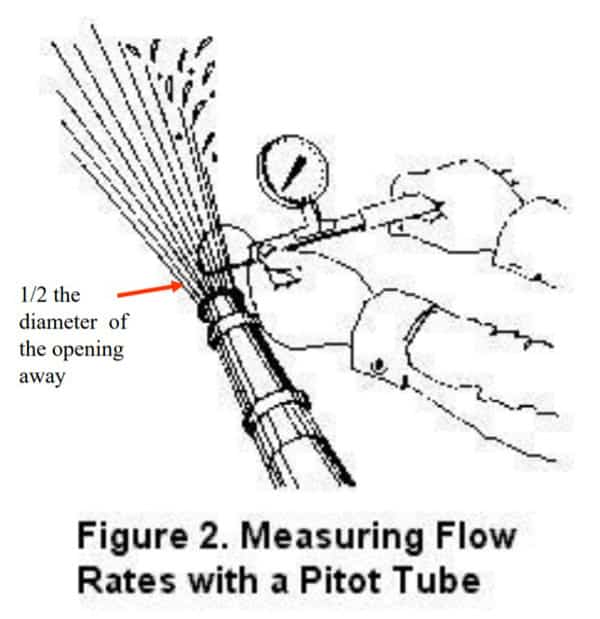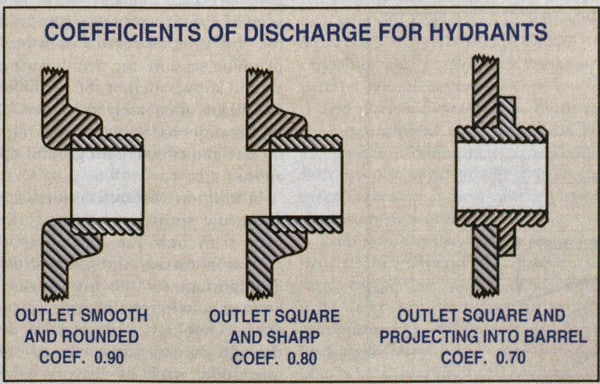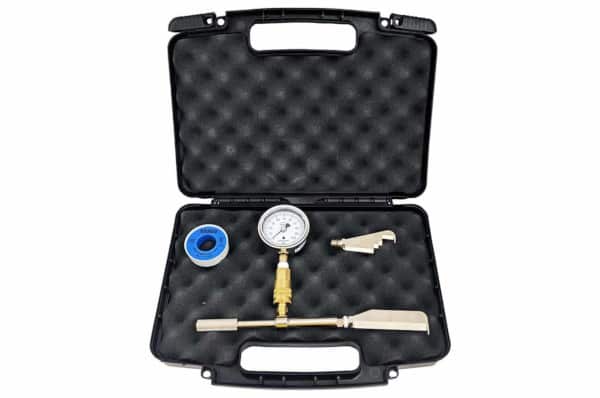How To Calculate Gallons Per Minute From Psi
Follow these simple steps to ensure burn hydrants can evangelize adequate water flow during a fire
Firefighting operations can be seriously jeopardized if burn hydrants aren't ready and able to deliver the required water flow and pressure. Municipalities and other government insist upon regular hydrant flow testing to ensure that acceptable water is available when it's needed most—which is where pitot gauges come up in.
In theory, pitot gauges make information technology simple to measure the menstruum of fire hydrants and convert readings in pounds per square inch (PSI) to gallons per minute (GPM), enabling inspectors to rapidly uncover reduced menstruum rates. Only in reality, the equation and chart can exist confusing—and QRFS phones are constantly ringing with the question: How do I do this right?
In this blog, we will take you stride-past-footstep through the process of converting a pitot gauge's PSI reading to GPM. We promise that we'll make it then simple even your grandmother could do it accurately—especially since we've provided a reckoner to help you make the conversion. Feel gratis to jump direct to the formula, followed by a pace-by-stride process and a calculator.
In the market for pitot gauges? Be sure to browse our selection of pitot gauge kits and accessories, including our acknowledged Inspector's Choice Pitot Gauge Kit, which costs a little more only delivers 1 percentage full-range accuracy.

Pitot gauge 101: here'south how they work
Fire hydrants are color-coded co-ordinate to their strength of output, enabling fire departments to appraise their water resources capabilities quickly when they arrive on the scene of an emergency. For instance, reddish hydrants typically accept a rated capacity of less than 500 GPM and light blue hydrants have a rated capacity of more than than 1,500 GPM. With and then much at stake, it's critical for hydrants to perform as expected during a fire.
A handheld pitot gauge is the quickest, simplest method for measuring straight-tip and hydrant-menstruum GPM. Analyzing the data it collects can besides reveal heavy pipe-wall deposits and closed valves that tin significantly impede a hydrant's pressure and flow.
Previously, nosotros've offered a detailed guide on how to utilize a pitot gauge for hydrant flow testing. But hither'southward a quick overview of how pitot gauges work:
A pitot gauge consists of iii components: a blade, handle, and force per unit area guess. After information technology's inserted into an open up burn hydrant's h2o belch, a narrow tube inside the blade directs water toward the estimate to create a pressure reading. Generally, the border of the blade is set parallel to the management of fluid-stream movement, at a distance about one-half the bore of the opening in the middle of the stream. Put simply, that means if the orifice is two.5 inches, the blade should exist most 1.25 inches out.

The captured PSI readings from a grouping of hydrants in the same vicinity are then used to calculate the disparities in pressure betwixt 2 points along the distribution system. But in lodge to empathize the results, the PSI readings demand to exist converted to GPM, the standard measurement of water menses. And that's where it gets a footling tricky.
PSI can't be directly converted to GPM; these are 2 different units of measure out. PSI measures pressure level and GPM measures menstruum rate.
Merely if other variables are known, the water'due south flow rate in GPM can be calculated with the help of the Bernoulli equation for incompressible fluid and conscientious unit of measurement conversion. Bernoulli, a Swiss mathematician, developed a formula that represents the human relationship betwixt velocity and pressure along a streamline.
Bernoulli'south original equation must be modified so that information technology accounts for the friction produced when water flows through a hydrant. When represented mathematically, the friction is chosen the "hydrant'due south coefficient" and is determined by the loss in catamenia acquired by the hydrant's internal orifice design.
The formula: what do all those variables mean?
Afterwards successfully completing the flow test and recording the information, here'south the formula used to decide the rate of discharge flowing from a unmarried fire hydrant in GPM:

Permit's break downward what those variables mean:
- 29.84 is a constant derived from physical laws relating to h2o velocity, pressure level, and conversion factors. In brusk, this number keeps the answer in GPM. Some sources offer a slightly smaller constant of 29.83.
- c d = the coefficient of belch, which represents friction loss.
- d = the actual within diameter of the hydrant orifice in inches.
- p = the pressure in PSI read at the orifice past the pitot gauge. Because this formula takes the foursquare root of p—rather than p itself—large increases in PSI will have a fairly small-scale impact on the terminal GPM.
- Q = a number used to represent the outcome, or discharge in GPM.
Finding the numbers to plug in for "d" and "p" are easy. To make up one's mind d, simply measure the inside bore of the hydrant's outlet or outlet nozzle where flow occurs; to discover p, record the pitot estimate reading.
The discharge coefficient, or "c," varies with the type of outlet on the hydrant. Different manufacturers have unlike internal hydrant orifice designs, and friction is created as water is required to get effectually bends or sharp corners.
In nearly modern hydrants, the transition betwixt the vertical butt of the hydrant and the horizontal outlet is smooth and rounded. In the diagram below, consider the difference between the transitions (which await like wings on either side of the center rectangle) in the first two outlet drawings. The rounded design has a coefficient of 0.9, significant there is just a x percent decline in water flow due to friction loss.

When the transition is square and sharp equally in the second drawing, the hydrant has a coefficient of 0.viii. When it is square and projects into the butt of the hydrant like the drawing on the right, the coefficient is 0.7. By poking your fingers inside the outlet, you can determine if it's smooth and rounded or foursquare and sharp. Compare your findings to the three general types of hydrant outlets in the diagram higher up to determine the coefficient of discharge.
Practice solving the equation yourself or with our custom hydrant discharge calculator
Now that you understand where the numbers come from, let's practise solving the equation. While testing a single fire hydrant, hither's what we found:
- The flow reading on the pitot guess is 62 psi.
- A unmarried 2.5-inch port is used with a measured inside bore of 2.55 inches. NFPA 291 : Recommended Practice For Fire Flow Testing And Marking Of Hydrants recommends using 2.v-inch outlets for menstruum tests instead of pumper outlets (which are larger than two.5 inches) considering the larger outlets don't make full completely and provide inaccurate pressure readings. If pumper outlets have to be used, the resulting catamenia must exist modified to account for the voids in water flow.
- The outlet is polish and rounded, meaning it has a coefficient of 0.9.
So, what'southward the total GPM bachelor at normal operating pressure?
Step 1: Multiply the constant 29.84 times the coefficient of belch (c d ). 29.84 x 0.9 = 26.856
Pace 2: Square the measured diameter. 2.55 ten 2.55 = 6.5025
Pace 3: Multiply those ii numbers: 26.856 10 6.5025 = 174.6
Step four: Notice the square root of 62 psi, which is 7.8740
Step v: Multiply the final two numbers to solve for Q, the discharge in GPM. 174.6 x seven.8740 = 1,375 GPM
Now that yous've got a grasp on how PSI, discharge coefficients, and bore impact a hydrant's menstruation rates, try our handy GPM calculator for burn down hydrants:
Watch this video for some other step-by-step example of how to use the pitot gauge'southward PSI reading to summate the rate of water flowing from the hydrant in GPM:
Theoretical discharge tables brand converting PSI to GPM even easier
Theoretical discharge tables, like the one we provide with our pick of pitot gauges, make the conversion even simpler. But find the pitot pressure reading on the left and slide your finger over to the matching orifice size to reveal the GPM.
But it'due south important to go on in mind that the tabular array is based on using a coefficient belch of 1 in the formula, which is the theoretical discharge from a perfect circular orifice.
In the real world, no orifice is perfect. When more accurate results are required, NFPA 291 explains that the coefficient advisable for your particular hydrant outlet should be applied to the figures on the table.
In other words, if your pitot pressure is 28 psi and your orifice size is four, your theoretical discharge co-ordinate to the table is two,526 GPM. If the coefficient of your hydrant outlet is 0.9, multiplying 2,526 x 0.nine finds the actual rate of period: ii,273.4 GPM.
Below is a theoretical discharge table from NFPA 291; information technology besides uses a perfect (impossible) coefficient discharge of i. Click on the prototype to run across the full-size version:

Pitot gauges help inspectors ensure that burn hydrants are ready and able to fight fires
Pitot gauges are the fastest and easiest way to measure the rate of discharge from fire hydrants – as long as you understand the proper steps to converting pressure readings in pounds per square inch to gallons per minute. Following these simple instructions helps inspectors deliver peace of listen that burn down hydrants volition perform every bit expected during a fire.

In the market place for pitot gauges? Be sure to browse our selection of pitot gauge kits and accessories, including our all-time-selling Inspector's Selection Pitot Gauge Kit, which costs a little more but delivers 1 percent full-range accurateness.
Questions most QRFS products or need a brand or item that's not in our online inventory? Just call united states at +1 (888) 361-6662 or email [electronic mail protected].
This weblog was originally posted at blog.qrfs.com. If this article helped you understand fire hydrant testing calculations, check us out at Facebook.com/QuickResponseFireSupply or on Twitter @QuickResponseFS.
Source: https://blog.qrfs.com/240-pitot-gauges-how-do-i-calculate-the-psi-to-gpm-conversion/

0 Response to "How To Calculate Gallons Per Minute From Psi"
Post a Comment